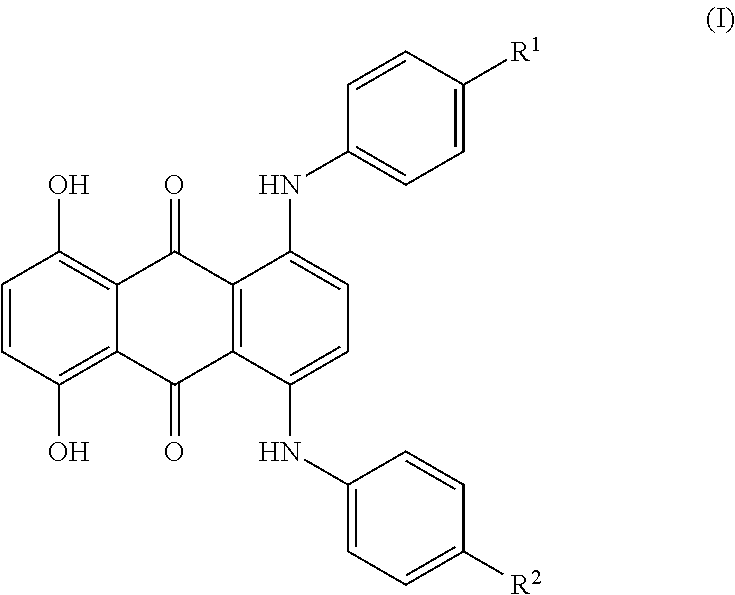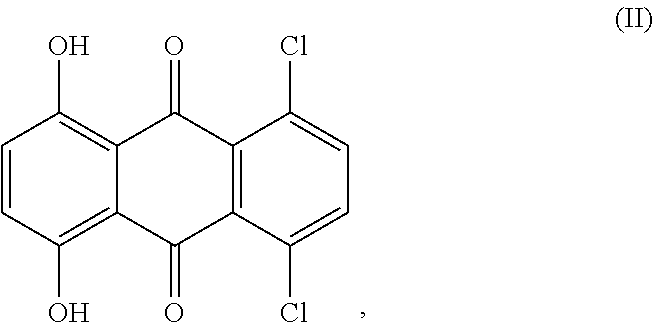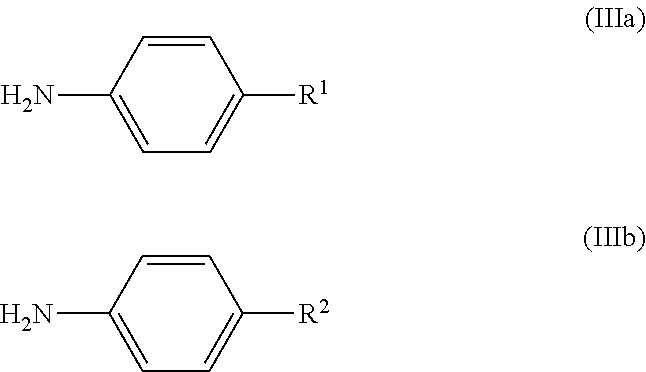Method for preparing phenylaminohydroxyanthraquinones
a technology of phenylaminohydroxyanthraquinones and phenylaminohydroxyanthraquinones, which is applied in the direction of anthracene dyes, dye addition to spinning solution, organic chemistry, etc., can solve the problems that the colouristic properties of products produced in such a manner no longer correspond to the current performance requirements, and achieve high purity, good yield, and improved colouristic properties
- Summary
- Abstract
- Description
- Claims
- Application Information
AI Technical Summary
Benefits of technology
Problems solved by technology
Method used
Image
Examples
example 1
[0052]Preparation of 1,4-bis(4-tert-butylphenylamino)-5,8-dihydroxyanthraquinone (in Analogy to EP-A 1 074 586, Non-Inventive)
[0053]100 g (1010 mmol) of N-methylpyrrolidone were initially charged in a glass reactor under passing nitrogen and heated to 70° C. 20 g (134 mmol) of p-tert-butylaniline were then added. Subsequently, 17 g (44 mmol) of 5,8-dichloro-1,4-dihydroxyanthraquinone (technical-grade, 80%) and 15.7 g (110.5 mmol) of disodium hydrogenphosphate were added and the reaction mixture was heated to 150° C. The reaction mixture was stirred at this temperature for 3 hours and then heated to 180° C. and stirred at this temperature for a further 10 hours. After completion of the reaction, the reaction mixture was cooled to 100° C. and 30 g of methanol were added. This mixture was stirred at 80° C. for one hour. After cooling to 50° C., the mixture was filtered through a Nutsche filter. The filter cake was firstly washed with 450 g of warm methanol and then with 1500 ml of warm...
example 2
[0055]Preparation of 1,4-bis(4-tert-butylphenylamino)-5,8-dihydroxyanthraquinone (in Analogy to EP-A 1 074 586, Non-Inventive)
[0056]The reaction and work-up was carried out exactly as in example 1, but 100 g of N-methylpyrrolidone were replaced by 100 g (680 mmol) of 1,2-dichlorobenzene.
[0057]Yield 23 g (98% of theory)
example 3
[0058]Preparation of 1,4-bis(4-tert-butylphenylamino)-5,8-dihydroxyanthraquinone (in Analogy to EP-A 1 074 586, Non-Inventive)
[0059]The reaction and work-up was carried out exactly as specified in example 1, but 100 g of N-methylpyrrolidone were replaced by 100 g (551 mmol) of 1,2,4-trichlorobenzene.
[0060]Yield 22.6 g (96.1% of theory)
PUM
| Property | Measurement | Unit |
|---|---|---|
| Temperature | aaaaa | aaaaa |
| Temperature | aaaaa | aaaaa |
| Fraction | aaaaa | aaaaa |
Abstract
Description
Claims
Application Information
 Login to view more
Login to view more - R&D Engineer
- R&D Manager
- IP Professional
- Industry Leading Data Capabilities
- Powerful AI technology
- Patent DNA Extraction
Browse by: Latest US Patents, China's latest patents, Technical Efficacy Thesaurus, Application Domain, Technology Topic.
© 2024 PatSnap. All rights reserved.Legal|Privacy policy|Modern Slavery Act Transparency Statement|Sitemap



